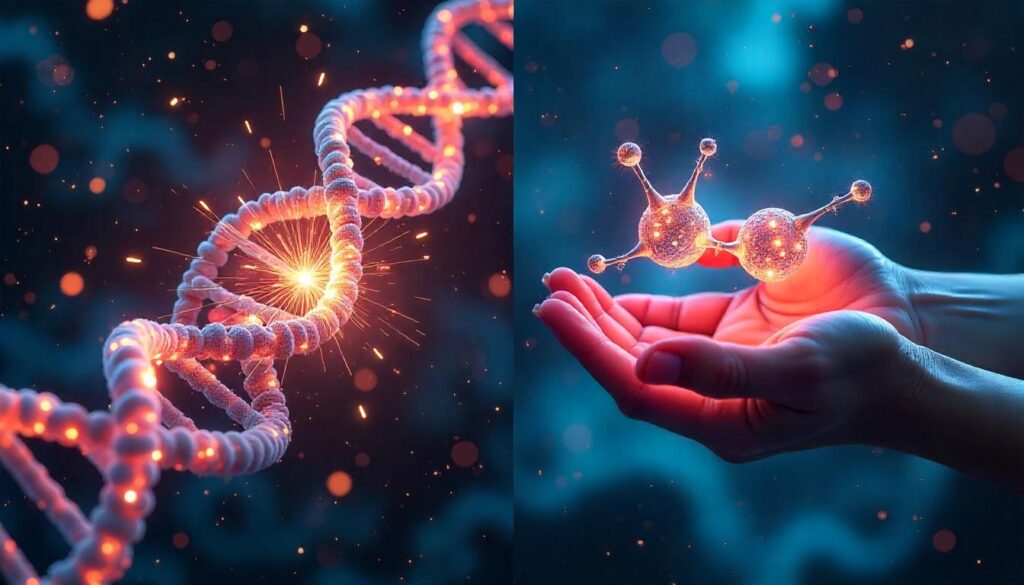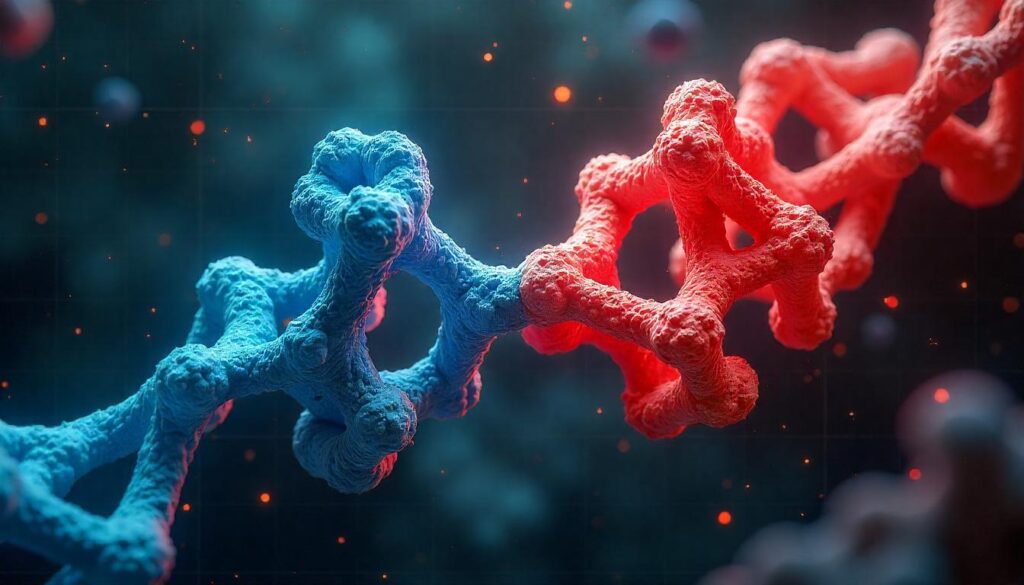“In 2025, while the world obsessed over AI tools and space tourism, biology quietly delivered breakthroughs that could reshape medicine, aging, evolution—and our understanding of life itself.”

When you think of “big discoveries,” the spotlight usually lands on AI, space missions, or robotics. But the real revolution this year might have happened in a laboratory, under a microscope, deep inside our very cells.
In this blog, we’ll explore two groundbreaking discoveries from 2025:
-
A new DNA repair system inside the human body involving a “bodyguard” protein called Nup98
-
A mind-bending protein discovery that defies one of biology’s core principles — the “handedness” (chirality) of life
These discoveries are not only scientifically validated but also carry enormous potential for future medicine, space biology, and synthetic life.
Let’s explore each in detail — in simple language, but with all the scientific depth you need to understand just how big this is.
Part 1: DNA’s Tiny Bodyguard — Nup98 and the Secret Repair Team Inside You

📍 The Discovery: A New Role for an Overlooked Protein
DNA damage happens constantly. Every day, your cells face insults from:
-
UV radiation
-
Pollutants
-
Oxidative stress
-
Even normal metabolic activity
And yet — your body repairs this damage quietly and efficiently, often without you ever knowing. But how exactly does it do that?
Enter Nup98, a protein previously known only for its role in nuclear transport (helping molecules move in and out of the nucleus).
In early 2025, researchers at NIH and Johns Hopkins discovered that Nup98 does much more than we thought. It acts like a first-responder and coordinator for DNA damage repair.
Here’s what it does:
-
Detects damage when DNA is broken
-
Forms liquid-like “bubbles” (condensates) around the damaged site
-
These “bubbles” shield the area and concentrate repair machinery right where it’s needed
-
The damage gets fixed faster and more accurately
📖 Published In:
👉 Science Journal: Nup98 organizes DNA repair condensates
👉 NIH Press Release: Nup98’s new role in DNA repair
🔍 Why This Matters So Much
Think of your DNA like a priceless manuscript. When it gets torn or stained, Nup98 doesn’t just sit idle — it grabs tools, builds a mini-repair shop on the spot, and gets to work.
This could redefine how we approach diseases like:
-
Cancer: Damaged DNA, if left unrepaired, leads to mutations and tumors.
-
Neurodegeneration: Faulty DNA repair is linked to diseases like Alzheimer’s.
-
Aging: Better DNA repair could slow down cellular aging.
In short: Your body is smarter than we ever knew, and now we have a potential way to support or mimic that intelligence for better health.
Part 2: A Protein That Works in a Mirror — Shattering Life’s One-Handed Rule

📍 The Discovery: Proteins Might Work in Reverse, Too
If the Nup98 news wasn’t wild enough, researchers in 2025 made another stunning discovery — one that challenges a fundamental assumption of biology: that all life on Earth is “left-handed.”
🧠 Wait… What Does “Handedness” Even Mean?
In chemistry, molecules like amino acids and proteins can exist in two mirror-image forms, just like your left and right hands. This is called chirality.
For some reason, all life on Earth uses left-handed amino acids — and nobody knows exactly why.
Scientists long believed that this molecular bias was fixed and that proteins made with right-handed amino acids wouldn’t work.
But in 2025, a team of biochemists reconstructed an ancient protein and flipped it into its mirror form.
The result? It still worked.
🔍 Why This Discovery Is Mind-Bending
This may sound niche, but the implications are huge:
-
It rewrites biology textbooks.
Life may not need to follow our “left-handed only” rule. There could be other forms of life — even on other planets — that evolved using right-handed amino acids. -
It opens new doors in medicine.
Mirror proteins are harder for enzymes to break down, meaning we could use them to make:-
Longer-lasting drugs
-
Biological materials that resist degradation
-
New immune therapies that the body can’t attack
-
-
It helps explain how life started.
One of the biggest mysteries in origins-of-life science is why chirality was biased in the first place. Now we know that bias may not have been a necessity.
What Does This Mean for the Future?
These two discoveries, while very different, both shake the foundations of what we thought we knew about life:
-
Nup98 shows that our cells are more advanced in damage response than previously imagined.
-
The mirror protein breaks rules that scientists considered universal.
Taken together, they paint a picture of a more flexible, adaptive, and resilient biology — one that could help:
-
Treat cancer and age-related diseases
-
Design robust biomaterials
-
Even rethink how we search for alien life or create artificial organisms
Simple Analogies to Help You Visualize It
- Nup98 = First-Aid Team
Imagine a workplace with instant emergency response. A worker gets injured, and in seconds, a mini first-aid booth assembles around them, with medics and tools arriving instantly. - Mirror Proteins = Ambidextrous Tools
Picture a screwdriver that can fit both left- and right-threaded screws — or a key that can open locks on either side of the door. That’s what this mirror-world protein is like.
Key Takeaways (for Busy Readers)
| Topic | Discovery | Why it Matters |
|---|---|---|
| 🧬 DNA Repair | Nup98 forms “repair bubbles” around damaged DNA | Could revolutionize treatments for cancer, aging, and genetic diseases |
| 🪞 Mirror Proteins | Ancient proteins can work in mirror form (right-handed) | Redefines life’s molecular rules and opens new paths for drug design & space biology |
FAQs (People Also Ask)
Potentially. It’s still early research, but targeting Nup98-like mechanisms could help develop drugs that boost DNA repair in cancer or aging cells.
Just like your left and right hands look similar but don’t overlap, molecules can exist in two forms — and usually only one works in life processes. Now, it turns out some proteins can work both ways.
Yes! If life can evolve with right-handed molecules, we may need to rethink how we look for extraterrestrial life — beyond Earth-like chemistry.
Related keywords
DNA repair 2025, Nup98 protein, mirror protein discovery, biology breakthroughs 2025, scientific discoveries 2025, protein folding, anti-aging research, genome stability, chirality in biology, future of medicine
References & External Sources:
-
Science.org – Nup98 organizes DNA repair condensates
-
NIH News – Nup98’s role in DNA repair
-
Nature – Mirror protein discovery
-
Phys.org – Life’s left-handed rule challenged
Final Thoughts
We often overlook the quiet power of biology — the tiny molecules doing heroic work inside us, or the ancient proteins that whisper secrets from life’s early days.
In 2025, science reminded us that:
-
Your body is a masterpiece of self-repair
-
Life may be more universal than we thought
-
And there’s still so much to discover in the tiniest places
If you enjoyed this blog, share it with a science lover — because this is where the real future begins.
